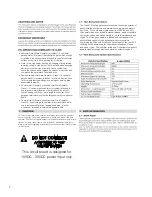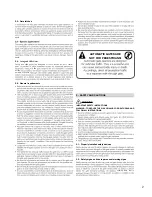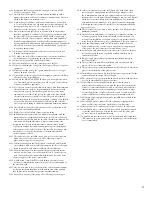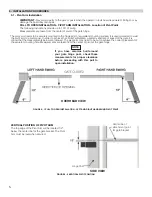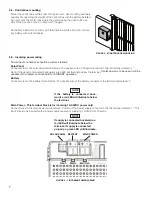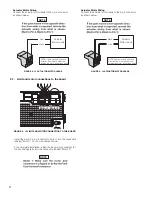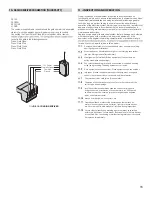
4
4.3.16 Protrusions shall not be permitted on any gate, refer to ATSM
F2200 for exceptions, if any.
4.3.17 Gates shall not be designed, constructed and installed in such a
manner that gravity will cause or initiate movement in any direction
whether the operator is attached or not.
4.3.18 A pedestrian gate shall not, under any circumstances, be attached
to, or incorporated into, and vehicular gate system in manner. This
also applies to any fence or wall, or any portion thereof, that the
gate may cover in the open or closed position.
4.3.19 Any non-automated gate that is to be automated in any manner
should be upgraded to conform to the provisions contained within
the provisions of this document and ASTM F2200 as applicable.
4.3.20 To reduce the risk of severe injury or death please read and under-
stand this entire manual and your local code requirements prior to
starting installation. Additionally, understanding the ASTM standards
will assist you in the proper assembly, installation and operation of
your gate opening system.
4.3.21 Disconnect all electricity and/or all sources of power before per-
forming any maintenance.
4.3.22 To reduce the risks of fire or injury always contact the installer or
distributor prior to performing any repairs or maintenance.
4.3.23 Never operate gate with obstructions present.
4.3.24 No one should ever cross the operative path of the gate.
4.3.25 Never let children play or linger in the vicinity of the gate or opener
equipment.
4.3.26 Never operate the gate or the opener when the opener is not oper-
ating or adjusted correctly.
4.3.27 Never allow children to play with or manipulate gate controls. Keep
all remotes away from children.
4.3.28 Only use the MANUAL RELEASE when gate is completely station-
ary. Untrained persons should never touch the gate or any releases
if any are installed or applicable.
4.3.29 Test the gate operator periodically (once every 6 months minimum).
Gate must reverse course or stop immediately upon contact with
any source in its path. Gate must stop and reverse course at any
time any object or other item crosses the path of the gate. Should
the safety sensors not stop and/or reverse the gates travel, imme-
diately investigate and repair the inoperative condition. Gate should
not be used under any circumstances, if all sensors and safety de-
vices are not performing to standards illustrated within this manual.
4.3.30 Gate should not be used if safety devices are not performing to all
local, state and federal guidelines.
4.3.31 Replace fuse only with fuse of same type and rating.
4.3.32 Installation of this gate system in a manner inconsistent with the
manufacturer’s recommended instructions, local, State, or Federal
law transfers the liability unto the installer. Careful consideration has
been taken by the manufacturer’s to devise safe measures, safe
design sad incorporate safety measures to prevent injury, death
or property damage. By circumventing, ignoring or modifying any
safety system or the exclusion thereof, the installer is creating a new
untested process outside the purview of the manufacturer and
therefore assumes all risk.
4.3.33 This unit is not to be installed on any gate, door or other structure
which serves to block, secure, close off or otherwise control a
pedestrian entry point or access point.
4.3.34 Vehicular swing gates shall be designed, constructed and installed
in accordance with security related parameters specific to the appli-
cation in question, with absolute safety in all considerations.
4.3.35 Never mount any device that operates the gate opener where the
user can reach around, over or through the fate to operate the con-
trols. Controls should be mounted at minimum, 8 feet away from
any moving part of the gate or gate system.
4.3.36 A hard wired control shall be located in such a manner so that
electronic communication between the two is never interrupted or
the wires damaged.
4.3.37 Any controls used to reset the device after obstruction/entrapment
protection incidents should be located within view of the gate and
should have safety features that prevent unauthorized use.
4.3.38 Never allow anyone to ride, hang on or otherwise touch the gate.
4.3.39 Safety sensors must be present at all times. The hard wired safety
sensors must be arranged and installed in such a manner so that
the communication between gate operator and sensor(s) are never
interrupted or severed by mechanical damage or movement. All items
which have sensors or safety devices installed must be constructed
or installed in such a manner so as to prevent removal or damamge.
All subsequent sensors must be suitable for the system installed and
approved for use.
4.3.40 Never increase the force used to move the gate, beyond the absolute
minimum required.
4.3.41 Never use force adjustments to compensate for binding, sticking or
resistant operation. These situations should be addressed and cor-
rected before installation of the gate operator. Gate systems should
swing freely in all directions prior to installation of this gate operator.
4.3.42 After any adjustment is made, all safety modes/features must be
tested. Gate must stop or reverse upon any object crossing the path
of the gate or the fate comes into contact with any object.
4.3.43 Activate gate only when the gate is in clear view of the user, the gate
system is properly adjusted, tested and verified, and there are no
obstructions present.
4.3.45 Keep gate and gate system properly maintained and properly in-
spected at all times.
4.3.46 This operator is intended for installation only on swing and slide
gates used to control vehicular traffic.
4.3.47 The gate must be properly installed and work freely in both directions
prior to the installation of the gate operator.
4.3.48 Install the gate operator only when the operator is appropriate for the
construction and the usage class of the gate.
4.3.49 The gate must be properly installed and work freely in both directions
prior to the installation of the gate operator.
4.3.50 Controls must be far enough from the fate so that the user is
prevented from coming in contact with the gate while operating the
controls. Controls intended to be used to reset an operator after two
sequential activations of the entrapment protection device(s) must
be located in the line of sight of the outdoor gate or easily accessible
controls shall have a security feature to prevent unauthorized use.
4.3.51 All warning signs and placards must be installed where visible in the
area of the gate.
4.3.52 Care shall be given to reduce the risk of nuisance tripping such as
when a vehicle trips the sensor while the gate is still moving.
4.3.53 Gate operators must utilize a contact sensor such as an edge sensor.
4.3.54 A hardwired contact sensor shall be located and its wiring arranged
so that the communication between the sensor and the gate opera-
tor is not subject to mechanical damage.
4.3.55 A wireless contact sensor such as one that transmits radio frequency
(RF) signals to the gate operator for entrapment protection functions
are recommended.
Содержание Titan 912L
Страница 2: ...TABLE OF CONTENTS...




